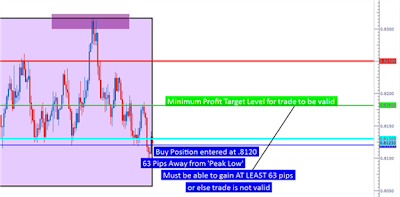In Forex trading, Tokyo session was noted the best session of the day to range trading. This statement surprising because some Forex traders believe the Asian session to be too slow market, or not very interesting to make enough of better profit. But the summary of the analysis was that since this Asian session was the most benefit period of the day for Foreign exchange traders, and since this time of the currency market was usually accented with slower market price fluctuations of lower scale - Forex traders would usually be right served by range trading; as the Tokyo session exhibited a far bigger tendency to respect support and resistance levels.
Trading ranges with Price action
The main objective with any range trading system should be to simply sell high and buy low. But this is not always so simple.
But what is high and what is low without any relative principle with which to compare?
This situation is where support and resistance levels can come into system. When market price is trading at or close support levels, market price is at an area in which preceding situations have seen demand come into the Foreign exchange market to make market prices higher. Resistance levels, on the other side, is a market price level in which supply trade into the Forex market to make precious situations of the same point lower.
How to trade ranges with Price action?
Range trading with price action can be done without the technical indicators at all. This trading strategy can give an additional point of comfort in the fact that previous market prices have an element of validation that not all iterations of support and resistance levels might take place.
For example, a S3 weekly pivot that hasn't seen a trade at that level does not technical classify as support levels until market price approaches it. Until an intersection occurs, it is just an arbitrary level.
With market price action, Forex traders are searching only at market price have moved in the Foreign exchange market, and thus, have got a form of validation that may not hold true with an arbitrary level of support and resistance levels.
Just because other patterns of support and resistance levels might not be fully consistent, it does not mean that those points can't give value.
Where support and resistance levels can help Forex traders is if they have been traded in the previous ; presenting a past validation of that support or resistance level with a market price action inflection.
An instance of this is if the pair traded towards 1.30 during the first portion of 2012. The market price of 1.30 is a primary level of support and resistance levels because it is a round, even whole number. Forex traders will usually analyze and thus trade with this primary levels since human nature will usually think in round numbers. If you see on the trading chart below, as market price traded lower toward this level of support, demand for the currency traded in - outstripping supply as the currency's price traded higher.
The value of Trading Ranges
Some of professional traders found that risk and reward were usually the main culprit of Forex traders failure ; and this was often because Forex traders would lose too many if traders were mistake and gain too small if they were right. The positive side of range trading is the fact that when support is broken while you're in a buy position, we can find to exit the position while mitigating the loss below the presumption that the range you're searching to get in - in no longer being respected anymore.
And if in a sell trading with a stop above resistance levels , and market price generally breaks above resistance trading higher - the Forex trader can once again mitigate the bearish side by exiting the trading as the range they're searching to short may no longer be accurate.






No comments:
Post a Comment